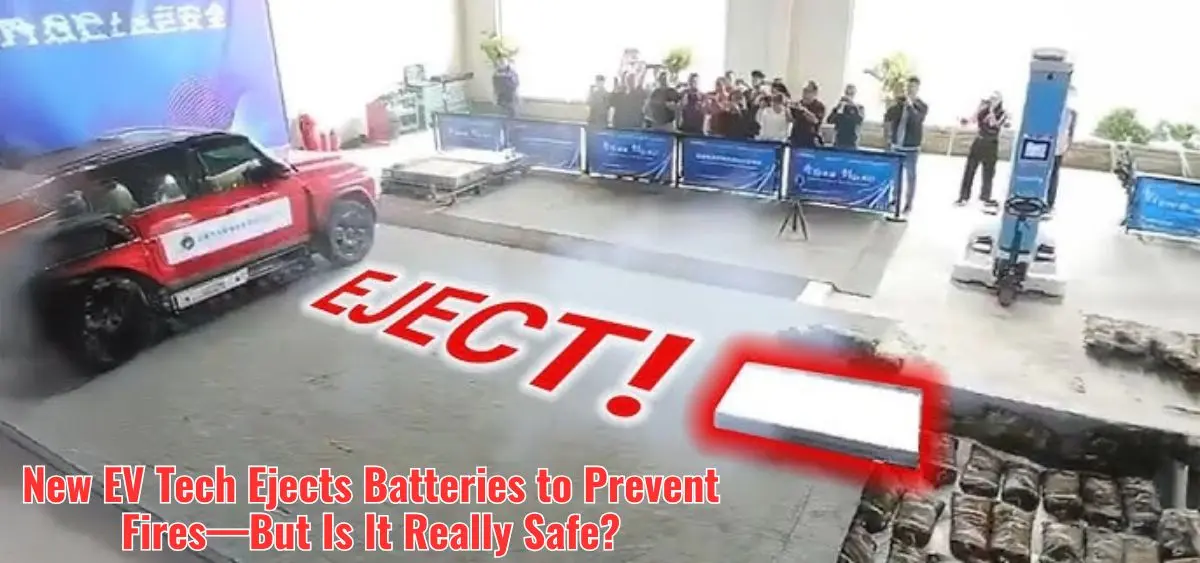Imagine a fiery EV battery being literally blasted out of a car to save lives — it sounds like science fiction, yet it’s real. New EV Tech Ejects Batteries to Prevent Fires, developed by Chinese engineers, promises to protect passengers from catastrophic battery fires by launching the pack away from the vehicle within seconds of detecting overheating. While the concept is bold and attention-grabbing, it raises urgent questions: could a flying, flaming battery become an even greater danger to pedestrians, nearby vehicles, or first responders? Dive in as we explore this revolutionary yet controversial approach to EV safety.
How does it work?
The system relies on three linked elements. First, onboard sensors continuously monitor for abnormal temperature rises or cell behavior that signal thermal runaway. Second, if thresholds are crossed, the system triggers a gas generator that rapidly separates the battery pack from the vehicle structure and propels it away. Third, the idea is that removing the volatile battery isolates the hazard, allowing occupants and first responders to focus on rescue and mitigation rather than containment inside the car.
Why are people alarmed?
While the concept solves one risk — a burning battery inside a cabin — it introduces others. Real-world concerns raised by safety experts and social-media commenters include:
- Projectile danger: A modern EV battery pack can weigh hundreds of kilograms. When fired with explosive force, it becomes a potentially lethal projectile capable of injuring people, damaging property, or colliding with other vehicles.
- Secondary ignition: The ejected pack remains energetic and can still ignite, releasing toxic gases or triggering fires wherever it lands — including on pedestrians, buildings, or another nearby EV. Critics have imagined a chain reaction: one ejected battery ignites another.
- Unpredictable trajectory: The demonstration used a prepared landing area; on busy roads, the pack’s path would be uncontrolled, and landing point would be unpredictable.
- Accidental deployment and failure modes: What if the system triggers during a minor fender-bender or fails to operate because the vehicle structure is compromised in a crash? Both scenarios could make matters worse.
- First-responder risk: An ejected, venting battery could expose bystanders and rescue teams to new hazards if it lands in the wrong place.
Community reaction
Online responses ranged from incredulous to outright hostile. Many pointed out the moral problem of shifting risk from occupants to the public. Others suggested alternative (and less dramatic) ideas — from parachutes to remote containment blankets — underscoring public discomfort with a solution that effectively “launches” danger outward.
Safer alternatives
Industry research offers alternative, less provocative approaches: better battery management systems that detect and preempt thermal issues; fire-resistant casings and insulation to contain events; integrated suppression and cooling systems within packs; firefighter-friendly access features; and longer-term shifts to safer chemistries, such as solid-state or sodium-ion batteries.
Conclusion
New EV Tech Ejects Batteries to Prevent Fires is undeniably bold, pushing the boundaries of how we think about EV safety. Yet, as innovative as it is, the concept exposes a critical dilemma: can we justify creating new external hazards while protecting passengers? Until extensive real-world testing, precise trajectory controls, and fail-safe mechanisms are in place, the technology remains more of a dramatic proof of concept than a practical solution. Ultimately, this system reminds us that true EV safety isn’t just about preventing internal fires—it’s about designing solutions that protect everyone on and around the road.
Related Articles:-

